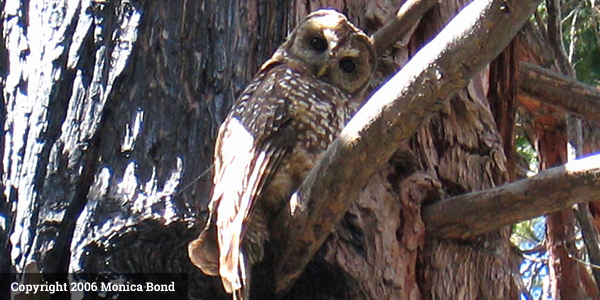FESA Protection Sought for California Spotted Owl
In the fall/winter of 2014, The John Muir Project (JMP) and Wild Nature Institute (WNI) wrote and filed a Petition to list the California Spotted Owl under the federal Endangered Species Act (ESA) to protect this species from extinction due to habitat loss from logging throughout its range.

BREAKING NEWS: September 18, 2015
US Fish and Wildlife Service has issued a Positive 90 Day Finding for the California Spotted Owl, determining that Listing this species as Threatened or Endangered under the Federal Endangered Species Act “May be Warranted” due to: their small and declining population; loss of habitat from logging and post-fire clearcutting; and lack of protections for their habitat under Federal Forest Plans and on private lands.
The 60 Day Comment Period Starts Today! Please submit comments in support of protecting this iconic Raptor before it is too late!
Scroll Down to View all other Petition Related Documents.
California Spotted Owl populations are declining alarmingly as a result of intensive mechanical “thinning” logging operations, and post-fire logging.
Mechanical thinning projects typically remove most of the trees in a given stand, including many mature and old trees up to nearly 8 feet in circumference (30″ in diameter), which degrades Spotted Owl nesting and roosting habitat (dense, mature/old forest). Post-fire logging removes the California Spotted Owl’s prime foraging/hunting grounds (complex early seral forest, created when high-intensity fire occurs in mature/old conifer forest). The only places the California Spotted Owl is not declining are on lands that are protected from logging in both burned and unburned forest (such as Sequoia/Kings Canyon National Park).
Unfortunately, protected forests comprise only a small percentage of the Owl’s range currently. It is estimated that within the State of California only about 1,200 pairs of California Spotted Owls exist today, about 30% less than estimates made just two decades ago. At this rate, the population could be lost in our lifetimes if stringent habitat protections are not put in place. Within the next several months, the U.S. Fish and Wildlife Service will determine whether listing this species as threatened or endangered may be warranted.
Related Documents
Petition Related Documents:
Petition to List the California Spotted Owl under the Federal Endangered Species Act
Appendix A to the CSO Petition
Appendix B to the CSO Petition
Appendix C to the CSO Petition
Appendix D to the CSO Petition
Appendix E to the CSO Petition
Appendix F to the CSO Petition
Appendix G to the CSO Petition
Press Release re Filing of the California Spotted Owl Listing Petition
